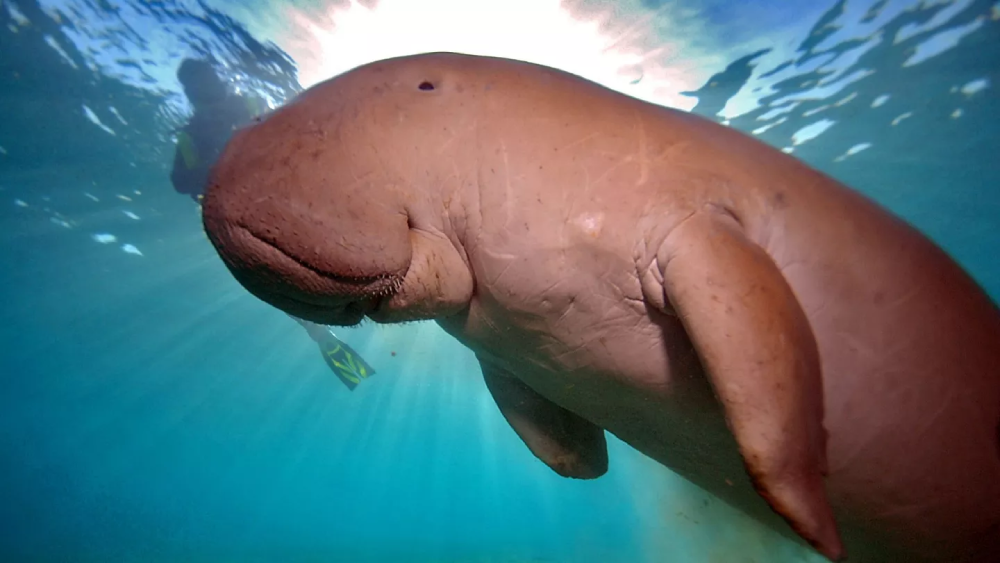In the vast expanse of the world’s oceans, there exists a creature of remarkable grace and gentle demeanor: the dugong. Often referred to as “sea cows” due to their herbivorous diet and slow-moving nature, dugongs are intriguing marine mammals that roam the warm coastal waters of the Indo-Pacific region. Despite their somewhat elephantine appearance, these creatures are more closely related to elephants than they are to cows, belonging to the order Sirenia, which also includes manatees.
Physical Characteristics
Dugongs possess a distinctive appearance that sets them apart from other marine mammals. Their bodies are streamlined and elongated, tapering to a paddle-like tail that propels them gracefully through the water. Covered in smooth, grayish-brown skin, dugongs are well-adapted to their aquatic environment. Their forelimbs have evolved into flippers, which they use for steering and maneuvering while swimming.
One of the most striking features of dugongs is their unique muzzle. This specialized adaptation allows them to efficiently graze on seagrass, their primary source of food. Dugongs have a limited number of teeth, which are continually replaced throughout their lives, aiding them in grinding down the tough and fibrous seagrass.

Habitat and Distribution of the Dugong
Dugongs live in shallow coastal waters, particularly in regions with extensive seagrass meadows. They inhabit a wide range of habitats, including bays, estuaries, lagoons, and coral reefs, where they can find ample food and refuge. The Indo-Pacific region, encompassing areas such as the Red Sea, Indian Ocean, and the waters surrounding Australia and Southeast Asia, serves as the primary range for dugongs.
Within these habitats, dugongs display a relatively sedentary lifestyle, preferring to establish home ranges and feeding territories. They are capable of traveling long distances in search of food and suitable breeding grounds but generally remain within familiar coastal areas throughout their lives.
Behavior and Diet
Dugongs are predominantly herbivorous, with seagrass making up the bulk of their diet. They are the only strictly herbivorous marine mammals, relying entirely on underwater meadows of seagrass for sustenance. Using their sensitive upper lips and muscular tongue, dugongs uproot seagrass from the ocean floor, consuming both the leaves and rhizomes.
Despite their large size, dugongs are surprisingly agile swimmers, capable of gliding gracefully through the water with ease. They perform acrobatic displays, such as breaching and tail-slapping, particularly during courtship and social interactions. Dugongs are generally solitary creatures, although they may form loose aggregations in areas with abundant food resources.
Reproduction and Life Cycle
Like many marine mammals, dugongs exhibit a slow reproductive rate. Females typically reach sexual maturity between the ages of six and seventeen, while males mature slightly later, between the ages of nine and fifteen. Courtship and mating occur year-round in some populations, while others exhibit seasonal breeding patterns.
After a gestation period of around 13 to 15 months, females give birth to a single calf, which is born underwater. Newborn dugongs are remarkably independent, able to swim and nurse shortly after birth. They rely on their mother’s milk for nourishment during the first year of life, gradually transitioning to a diet of seagrass as they grow older.
The bond between mother and calf is strong, with the mother providing guidance and protection until the calf is old enough to fend for itself. Dugongs live for several decades in the wild, with some individuals reaching ages of up to 70 years or more.
Conservation Status and Threats
Despite their remarkable adaptations and widespread distribution, dugongs face numerous threats to their survival, primarily due to human activities. Habitat loss and degradation pose significant challenges, as coastal development, pollution, and the destruction of seagrass habitats threaten the availability of suitable food and shelter.
Additionally, dugongs are vulnerable to entanglement in fishing gear, collisions with boats and vessels, and illegal hunting and poaching. In some parts of their range, dugongs are hunted for their meat, oil, and other body parts, despite legal protections and conservation efforts aimed at safeguarding these vulnerable marine mammals.
Efforts to conserve dugong and their habitats involve a combination of measures, including habitat protection, fisheries management, education and outreach, and the establishment of marine protected areas. Collaborative initiatives involving governments, conservation organizations, local communities, and indigenous peoples play a crucial role in safeguarding the future of these gentle giants of the sea.
Conclusion
The dugong occupies a unique and important niche in the marine ecosystem, playing a vital role in maintaining the health and balance of coastal habitats. With their peaceful demeanor and graceful movements, these gentle giants inspire awe and admiration in all who encounter them. By working together to address the various threats facing dugongs and their habitats, we can ensure that future generations will continue to marvel at the beauty and wonder of these remarkable creatures for years to come.









